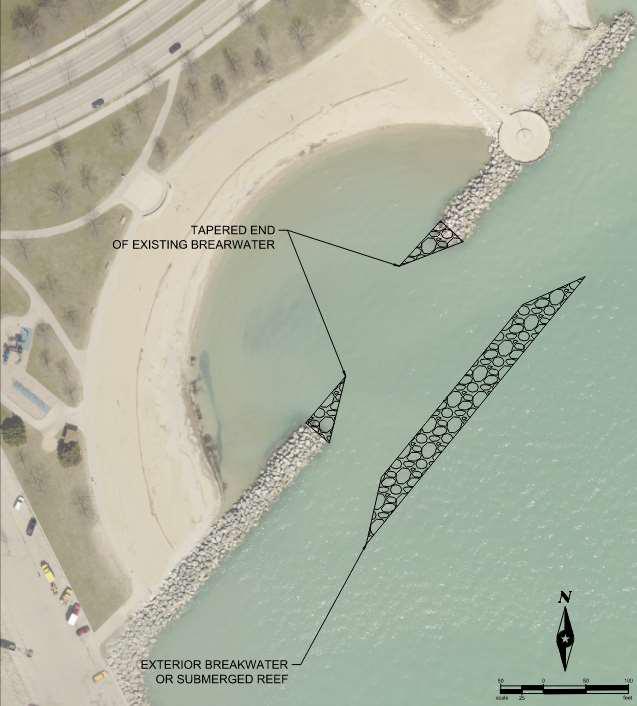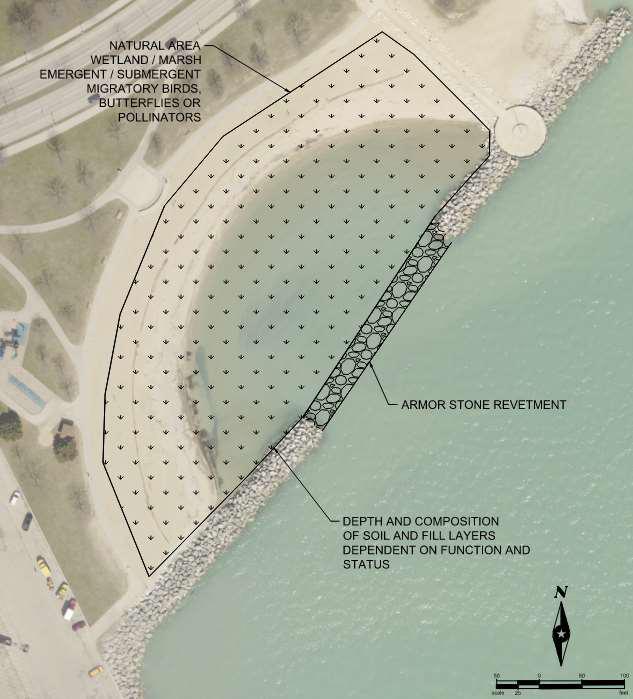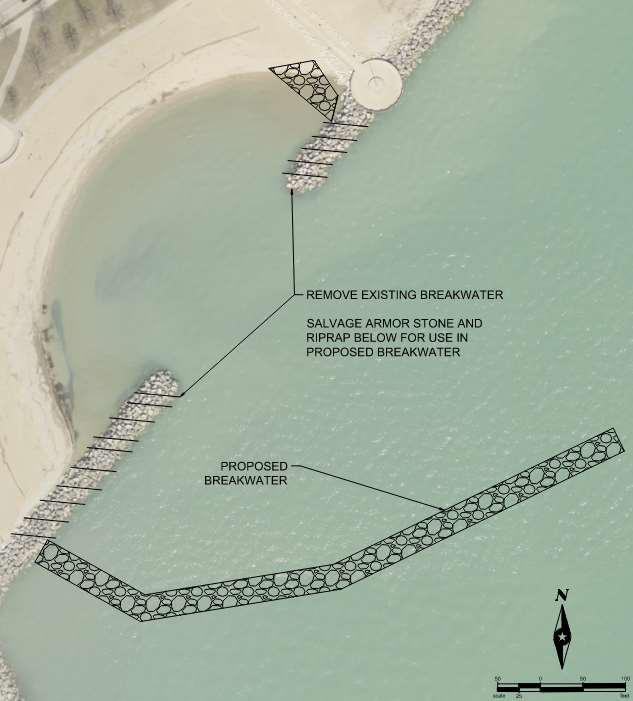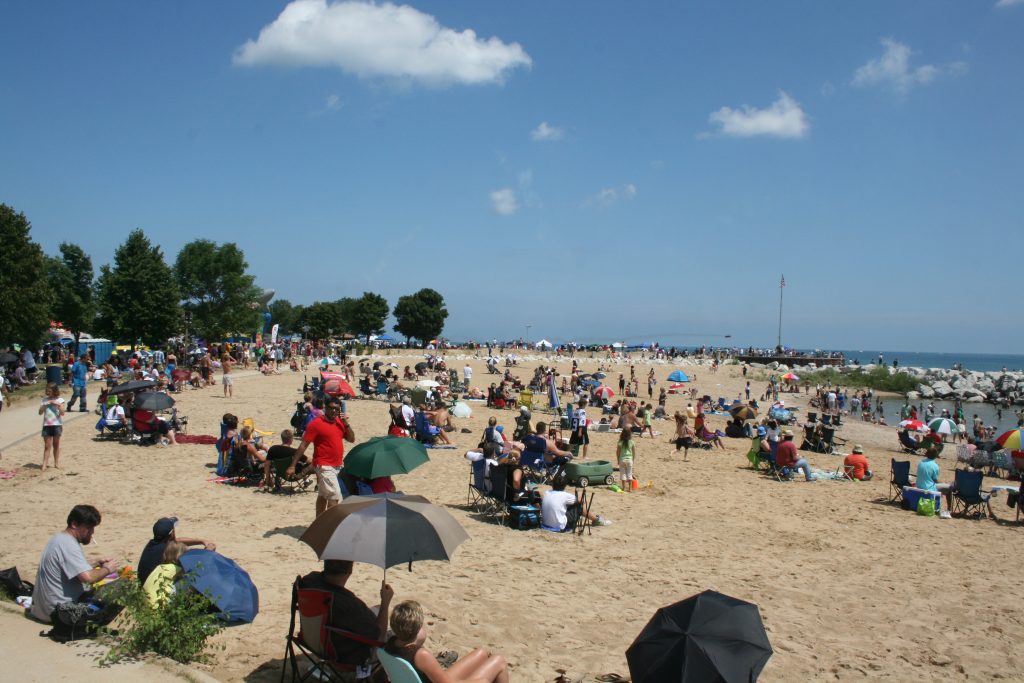Dangerous McKinley Beach Can Be Fixed
Parks committee reviews preliminary solutions, with price tag ranging from $250,000 to $4.9 million
There are dangerous, even deadly, beach conditions at McKinley Beach. After a series of drownings at the beach in 2020, Milwaukee County commissioned a study of the conditions and possible solutions, but whether the county can afford to fix the beach is another matter.
The board’s Parks, Energy and Environment Committee recently saw the initial findings of the study and some concepts for addressing the dangerous water conditions, like rip currents, that took the lives of three people in 2020 and caused several near drownings. The county closed the beach in late summer 2020 and it remained closed for all of summer 2021.
The preliminary solutions for the deadly water conditions include rebuilding or modifying the breakwaters and beach and range in cost from $1.3 to $4.9 million. Another possibility, which involves filling in the swimming area between the north and south breakwaters with sand, has an estimated cost of $250,000. Wasserman showed an interest in that cheaper option, asking parks to look into excavating sand from the lakebed to fill in the beach area.
Sarah Toomsen, parks manager for planning and development, noted that whatever solution is ultimately chosen, parks will need operating funds to maintain it. “We have to invest in the maintenance obligations that would keep that asset functional,” she said.
Even the cheapest option of filling in the swimming area with sand is not a one-time cost, as it will need to be refilled with additional sand from time to time.
Heather Stabo, a senior engineer with SEH, worked as an engineering consultant on the study. She told supervisors that they looked at historical wind and water data for the area, and conducted field tests on current wind and wave conditions. The study produced some findings that shed light on the conditions present in 2020.
One was that all the incidents occurred on days when the wind was coming from the south and southwest. Ripcurrents in the lake can be caused by wind.
Second, the study found 2020 was a year of historic high water levels for Lake Michigan, not experienced since 1986. This caused the water depth between the breakwaters to reach as much as six feet. “The rip currents that we were experiencing were able to form because there was a larger water column in which they could form, right in between this area where everything is being channelized,” Stabo said.
But water levels can be a difficult variable to engineer. Historic data shows that 2020 was one of a handful of years during the past century with historically high water levels. But whether they will continue to rise isn’t so easy to pin down.
Wave heights also play a role in the swimming conditions. In 2020, wave heights reached two feet at some point on each of the three days that saw a deadly drowning at McKinley. The average wave height at the beach is one and a half feet. Stabo said two feet is still dangerous for some swimmers “because it’s small enough that it looks like you can go play in it and it’s gonna be fun, it’s big enough that if you are an inexperienced or even a moderate swimmer that you can lose your footing.”
While a long-term solution to dangerous swimming conditions will require a re-engineering of the beach, there are some “soft solutions” the county can consider in the meantime, according to the project team. These include beach closure, public outreach and a swim warning system.
The warning system would use indicators like colored flags to indicate swimming conditions. But varied conditions of the beach and the many variables that can affect swimming conditions there could make it hard to reliably run such a warning system, Stabo said.
Below are four different preliminary engineering concepts to fix the beach.

Concept One
This first option (above) would remove the southern breakwater, and let the area on the northern side of the beach fill. Stabo said this area regularly fills with biomatter that washes ashore. Removing the breakwaters would eliminate the rip currents. It would also eliminate some of the protection offered to Lincoln Memorial Drive and McKinley Marina. For this reason, reinforced retaining steps would be added to the southern end of the beach. Estimated Price Tag: $1.3 million.

Concept Two
This second option would put a submerged offshore breakwater outside of the existing breakwaters. However, the project team doesn’t favor this option as it could invite people to swim further into the lake and create stagnant water conditions along the beach. Estimated price tag: $3.7 million.

Concept Three
This option would have the county connect the two breakwaters filling in the area and allow a natural wetland or a marsh to take hold. Estimated price tag: $2.3 million.

Concept Four
This option would amount to restoring the beach to the depths and conditions of its original construction in the 1980s. This would bring the average water depth to two and a half feet between the breakwaters and the beach. It would require refilling of sand from time to time in the future. Estimated price tag: $250,000

Concept Five
This option is based in part on the Children’s Pool beach in San Diego. It would see both breakwalls removed. A new, larger breakwall would be built off of the southern end of the beach, and a smaller breakwall on the northern end. Though Stabo said there would still likely be currents running along the edge of the breakwall. Estimated price tag: $4.9 million
MKE County
-
Due To Deficit, MCTS Considering Hiring Freeze
 Jul 4th, 2025 by Graham Kilmer
Jul 4th, 2025 by Graham Kilmer
-
State Budget Provides Funding For Milwaukee Highway Patrol
 Jul 4th, 2025 by Graham Kilmer
Jul 4th, 2025 by Graham Kilmer
-
Domes Plan Requires $30 Million From County
 Jul 2nd, 2025 by Graham Kilmer
Jul 2nd, 2025 by Graham Kilmer























$4.9MM: there would still likely be currents running along the edge of the breakwall.
* Why is this a proposed option if it doesn’t solve the problem?
$3.7MM: the project team doesn’t recommend this option.
$2.3MM: Getting rid of the beach is an option I guess.
$1.3MM: eliminates some of the protection offered to Lincoln Memorial Drive and McKinley Marina.
* I can see losing protection for Lincoln Memorial Drive but what are you talking about losing protection for Mckinley Marina – what protection to barriers that run parallel to the shoreline give to the marina that’s protected by the government pier?
$0.25MM: would require refilling of sand from time to time in the future.
* Big deal, isn’t this the obvious solution, we keep the beach, we make it safe and it’s the cheapest option initially (we could spend that money 5x and still be $50K cheaper than the $1.3MM solution). I guess I go with $1.3MM option if I anticipate spending $1.3MM over 10yrs (but this Marina was designed in the 1980’s and in 2020 is just became a problem – so solution of filling with sand ought to last ~30+ years.
Tides move in and out of the Lake Michigan shoreline every day because of a phenomena known as “seich”. The water in Lake Michigan constantly flows from one side of the lake to the other. As the water pushes to the Wisconsin side, the water levels rise in the rivers. Just ask any fly fisherman looking tor Steelhead trout in Milwaukee’s Menomonee River during the Spring spawing run.
Lake seiches can occur very quickly. On July 13, 1995, a large seiche on Lake Superior caused the water level to fall and then rise again by three feet within fifteen minutes, leaving some boats hanging from the docks on their mooring lines when the water retreated. The same storm system that caused the 1995 seiche on Lake Superior produced a similar effect in Lake Huron, in which the water level at Port Huron changed by 6 feet over two hours. On Lake Michigan, eight fishermen were swept away from piers at Montrose and North Avenue Beaches and drowned when a 10-foot seiche hit the Chicago waterfront on June 26, 1954.
Not sure if it’s possible to protect McKinley Beach swimmers from a large seich.
https://en.wikipedia.org/wiki/Seiche
For public projects such as increasing the safety and viability of McKinley Beach, federal and state funding, as well as other types of grants, are often available. The costs of any undertaking would likely not fall solely on Milwaukee County taxpayers.
Milwaukee’s exceptional lakefront, thoughtfully created over many decades, is an economic and cultural asset valued far beyond the city and county limits.